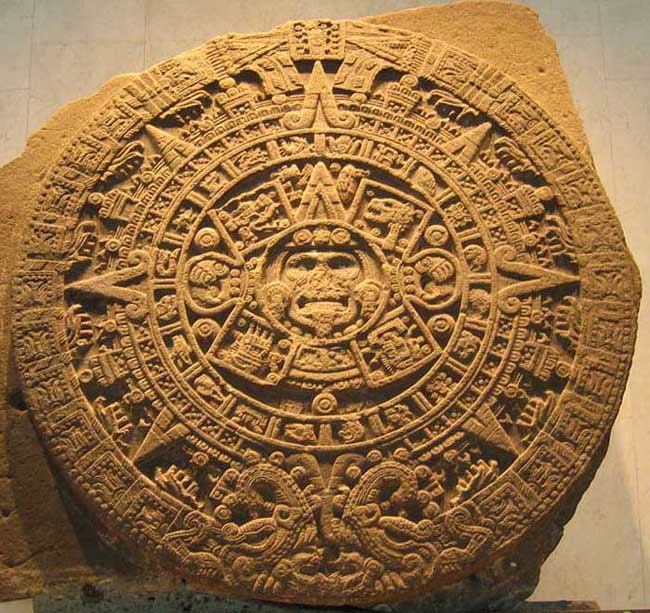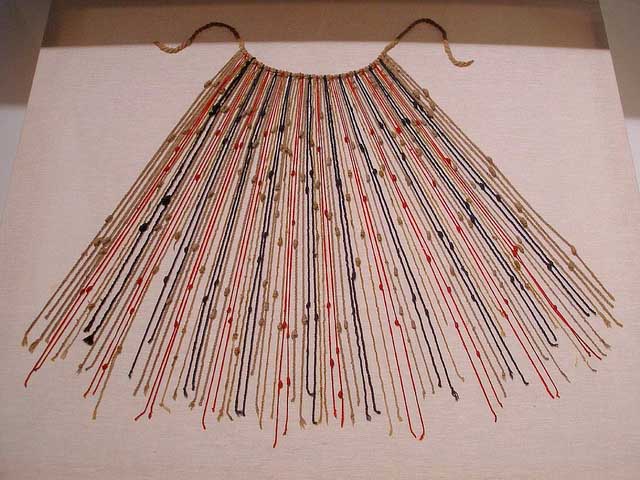
Sun Stone

Sun Stone
The Pre-Columbian people of Mesoamerica kept track of time with calendars which had ritual and religious meaning. While the Julian calendar came to the region when it was conquered by Spain in the 16th century, and the Gregorian calendar is now in general use, in a few communities some Native American of the area still use the ancient count of days as well.
All of the Mesoamerican cultures shared a 260 day ritual calendar, for example, the Tzolkin of the Maya civilization. In many Mesoamerican cultures people were given the name of the day in this cycle on which they were born (sometimes in addition to another name). This 260 day cycle ran concurrently with a 365 day vague solar year. These two calendars came together every 52 years.
This 52 year cycle, sometimes called a Calendar round, was very significant. Commonly elaborate rituals would be held at the end of each calendar round, with all fires extinguished, old pots broken, and a new fire kindled symbolizing a fresh start. There was a belief in cycles within time, for example that if a significant event happened on a certain day in the 52 year cycle, a similar or related event was likely to happen on the same day in the next 52 year cycle.
This 52 year cycle was by far the most important for most Mesoamericans, with the apparent exception of the Maya elite until the end of the Classic Era, who gave equal importance to the Maya Long Count Calendar. Other calendar cycles were also kept track of, such as a lunar calendar, as well as the cycles of other astronomical objects, most importanly Venus.

So little is known about the calendar used by the Inca that one can hardly make a statement about it for which a contrary opinion cannot be found. Some workers in the field even assert that there was no formal calendar but only a simple count of lunations. Since no written language was used by the Inca, it is impossible to check contradictory statements made by early colonial chroniclers.
It is widely believed that the quipus of the Inca contain calendrical notations, but no satisfactory demonstration of this is possible.
Most historians agree that the Inca had a calendar based on the observation of both the Sun and the Moon, and their relationship to the stars.
Names of 12 lunar months are recorded, as well as their association with festivities of the agricultural cycle; but there is no suggestion of the widespread use of a numerical system for counting time, although a quinary decimal system, with names of numbers at least up to 10,000, was used for other purposes. The organization of work on the basis of six weeks of nine days suggests the further possibility of a count by triads that could result in a formal month of 30 days.
The smallest unit of this calendar was a numerical count of three days, which, interacting with a similar count of 10 days, formed a standard 30-day "month." Every third year was made up of 13 moons, the others having 12. This formed a cycle of 37 moons, and 20 of these cycles made up a period of 60 years, which was subdivided into four parts and could be multiplied by 100. A period of 20 months is also mentioned. Although the account of the Chibcha system cannot be accepted at face value, if there is any truth in it at all it is suggestive of devices that may have been used also by the Inca.
In one account, it is said that the Inca god Viracocha established a year of 12 months, each beginning with the New Moon, and that his successor, Pachacuti, finding confusion in regard to the year, built the sun towers in order to keep a check on the calendar. Since Pachacuti reigned less than a century before the conquest, it may be that the contradictions and the meagreness of information on the Inca calendar are due to the fact that the system was still in the process of being revised when the Spaniards first arrived.
Despite the uncertainties, further research has made it clear that at least at Cuzco, the capital city of the Inca, there was an official calendar of the sidereal-lunar type, based on the sidereal month of 27 1/3 days. It consisted of 328 nights (12 27 1/3) and began on June 8/9, coinciding with the heliacal rising (the rising just after sunset) of the Pleiades; it ended on the first Full Moon after the June solstice (the winter solstice for the Southern Hemisphere).
This sidereal-lunar calendar fell short of the solar year by 37 days, which consequently were intercalated. This intercalation, and thus the place of the sidereal-lunar within the solar year, was fixed by following the cycle of the Sun as it "strengthened" to summer (December) solstice and "weakened" afterward, and by noting a similar cycle in the visibility of the Pleiades.
Reference: Encyclopedia Britannica
ANCIENT AND LOST CIVILIZATIONS INDEX